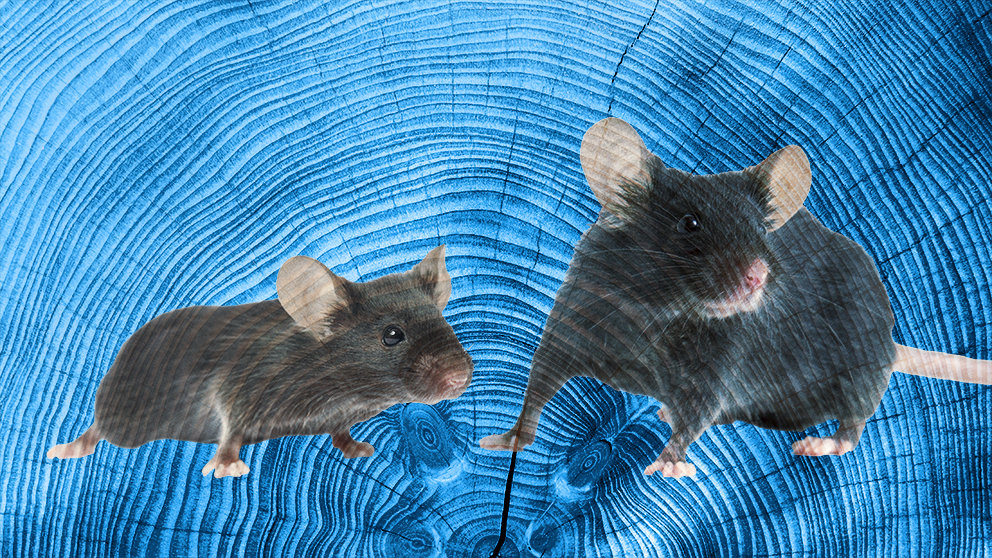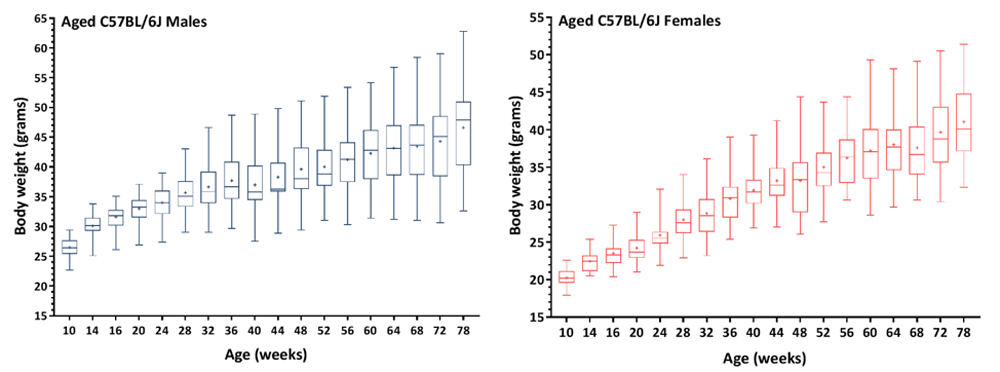Know Thy Mouse: Variability in Aged Mice
 |
Before undertaking a large study, it’s very beneficial to understand the biology of the model you are going to work with. This is particularly important when it comes to aging studies because it takes so much time to age your mice – so before you start, be sure to get your baseline data!
One important consideration is that many physiological characteristics can become more variable in aged mice (>25 weeks of age) compared to young mice (< 25 weeks of age). For example, in Figure 1 we show the differences in weight data between 10 weeks and 78 weeks of age. In the young mice, the range of normal weights have a 5-7 grams range – but by 78 weeks the range in weights can be quite large – a 20-30 gram range!
 |
|
Figure 1. Weight increases with age but also shows increased variability in older mice. Groups of 30 male and 30 female C57BL/6J mice were weighed starting at 10 weeks of age until 78 weeks of age. Mice were fed a diet containing 6% fat (LabDiet® 5K52 formulation).
|
Here are some key pointers for your aging study.
- Collect your own data!
Basic physiological data is available for both young (8 & 16 weeks) and aged (24-78 weeks) C57BL/6J mice on The Jackson Laboratory website. But these data are meant to serve as a basic reference. It’s important that you collect your own data in your facility. Different food, different cage types, different water systems, different health status – these are all some of environmental differences that can have an effect on the phenotype in your facility.
- Use the Literature!
Although performing a pilot before starting a large experiment is ideal – with aged studies even a pilot could take over a year! In order to get a sense of the variability of the phenotype you are studying, it’s helpful to look through the literature to find a couple different data sets to compare. This will give you a rough idea of the kind of variability you might see in your facility. Although it’s not a substitute for your own data, it is a good reference.
One place you can go to find datasets (particularly on commonly used inbred strains) is the Mouse Phenome Database (MPD). This database contains a variety of datasets that have been collected and uploaded from different labs and facilities.
- Acclimation of your mice
When you receive new mice, or move mice from one room or facility to another – you need to give those mice time to acclimate to their new environment. Travel or movement may affect the physiology of the mice – and if you start taking measurements on the day of arrival your data may not be reflective of what is the normal variation in your facility. For example, mice may lose during transit but will often gain that weight back after arrival.
In general, we recommend giving your mice two days if moving between rooms in the same facility and a week after receiving mice from a new facility.
- Different ages? Different normal!
As shown in Figure 1, aged B6J mice have greater variability than younger B6J mice. When you are collecting your data for your studies, you need to make sure you collect the reference data from the same ages that you plan to work with. Even when working with adult ages, there is a difference in the range and standard deviation between adult mice that are ~3 months versus adult mice that are ~12 months. These differences could mean that you need to have a larger effect size in order to have the power to see a statistical difference between your experimental and control groups.
Understanding the normal variability in the mice that you are working with is critical to perform statistically rigorous studies. This phenotypic variability can change by strain, by genotype, by facility and by age. Before you start, know thy mouse! Be sure to visit the Aged B6J mouse page help you learn more about your aged mouse model from JAX.